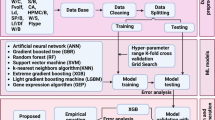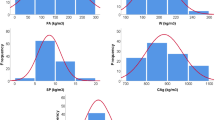Abstract
While various kinds of fibers are used to improve the hot mix asphalt (HMA) performance, a few works have been undertaken on the hybrid fiber-reinforced HMA. Therefore, the fatigue life of modified HMA samples using polypropylene and polyester fibers was evaluated and two models namely regression and artificial neural network (ANN) were used to predict the fatigue life based on the fibers parameters. As ANN contains many parameters such as the number of hidden layers which directly influence the prediction accuracy, genetic algorithm (GA) was used to solve optimization problem for ANN. Moreover, the trial and error method was used to optimize the GA parameters such as the population size. The comparison of the results obtained from regression and optimized ANN with GA shows that the two-hidden-layer ANN with two and five neurons in the first and second hidden layers, respectively, can predict the fatigue life of fiber-reinforced HMA with high accuracy (correlation coefficient of 0.96).
Similar content being viewed by others
References
AIREY G D. Fundamental binder and practical mixture evaluation of polymer modified bituminous materials [J]. International Journal of Pavement Engineering, 2004, 5(3): 137–151.
KIM Y R. Modeling of asphalt concrete [M]. Reston: McGraw-Hill Professional, 2009: 1–16
FITZGERALD R L. Novel applications of carbon fiber for hot mix asphalt reinforcement and carbon-carbon pre-forms [D]. Michigan: Michigan Technological University, 2000.
BENEDETTO H D, SOLTANI A A, CHAVEROT P. Fatigue damage for bituminous mixtures: A pertinent approach [J]. Journal of the Association of Asphalt Paving Technologists, 1996, 65: 142–158.
DANIEL J S, KIM Y R. Laboratory evaluation of fatigue damage and healing of asphalt mixtures [J]. Journal of Materials in Civil Engineering, 2001, 13(6): 434–440.
KHATTAK M J, BALADI G Y. Fatigue and permanent deformation models for polymer-modified asphalt mixtures [J]. Journal of the Transportation Research Board, 2001, 1767(1): 135–145.
KIM Y R, LITTLE D N, LYTTON R L. Fatigue and healing characterization of asphalt mixtures [J]. Journal of Materials in Civil Engineering, 2003, 15(1), 75–83.
HUANG Hai-ming, WHITE T D. Dynamic properties of fiber-modified overlay mixture [J]. Journal of the Transportation Research Board, 1996, 1545: 98–104.
TAPKIN S. The effect of polypropylene fibers on asphalt performance [J]. Building and Environment, 2008, 43(6): 1065–1071.
WU Shao-peng, YE Qun-shan, LI Ning. Investigation of rheological and fatigue properties of asphalt mixtures containing polyester fibers [J]. Construction and Building Materials, 2008, 22(10): 2111–2115.
SERFASS J P, SAMANOS J. Fiber-modified asphalt concrete characteristics, applications and behavior [J]. Journal of the Association of Asphalt Paving Technologists, 1996, 65: 193–230.
NAJD A, ZHENG Chuan-chao, GUO Jin-ying. Experiments of fracture behavior of glass fiber reinforced asphalt concrete [J]. Journal of Chang’an University, 2005, 25(3): 28–32.
JAHROMI S G, KHODAII A. Carbon fiber reinforced asphalt concrete [J]. The Arabian Journal for Science and Engineering, 2008, 33(2B): 355–364.
LEE S J, RUST J P, HAMOUDA H, KIM Y R, BORDEN R H. Fatigue cracking resistance of fiber-reinforced asphalt concrete [J]. Textile Research Journal, 2005, 75(2): 123–128.
MONISMITH C L, EPPS J A, FINN F N. Improved asphalt mix design [J]. Journal of the Association of Asphalt Paving Technologists, 1985, 54: 347–406.
Shell pavement design manual: Asphalt pavements and overlays for road traffic [M]. London: Shell International Petroleum, 1978: 1–354.
Research and development of the asphalt institute’s thickness design manual (ms-1). Ninth edition [M]. Lexington: Asphalt Institute, 1982: 1–204.
TAYEBALI A A, TSAI B, MONISMITH C L. Stiffness of asphalt-aggregate mixes [M]. Washington DC: Strategic Highway Research Program, National Research Council, 1994.
BIRGISSON B, SORANAKOM C, NAPIER J A L, ROQUE R. Microstructure and fracture in asphalt mixtures using a boundary element approach [J]. Journal of Materials in Civil Engineering, 2004, 16(2): 116–121.
HOSSAIN M, SWARTZ S, HOQUE E. Fracture and tensile characteristics of asphalt-rubber concrete [J]. Journal of Materials in Civil Engineering, 1999, 11(4): 287–294.
READ J M, COLLOP A C. Practical fatigue characterization of bituminous paving mixtures [J]. Journal of the Association of Asphalt Paving Technologists, 1997, 66: 74–108.
BOSURGI G, TRIFIRÒ F. A model based on artificial neural networks and genetic algorithms for pavement maintenance management [J]. International Journal of Pavement Engineering, 2005, 6(3): 201–209.
JAN J C, HUNG S L, CHI S Y, CHERN J C. Neural network forecast model in deep excavation [J]. Journal of Computing in Civil Engineering, 2002, 16(1): 59–65.
JUANG C H, CHEN C J. CPT-Based liquefaction evaluation using artificial neural networks [J]. Computer-aided Civil and Infrastructure Engineering, 1999, 14(3): 221–229.
MIRZAHOSSEINI M R, AGHAEIFAR A, ALAVI A H, GANDOMI A H, SEYEDNOUR R. Permanent deformation analysis of asphalt mixtures using soft computing techniques [J]. Expert Systems with Applications, 2011, 38(5): 6081–6100
NAZZAL M D, TATARI O. Evaluating the use of neural networks and genetic algorithms for prediction of subgrade resilient modulus [J]. International Journal of Pavement Engineering, 2012, 14(4): 364–373.
OZGAN E. Artificial neural network based modelling of the Marshall stability of asphalt concrete [J]. Expert Systems with Applications, 2011, 38(5): 6025–6030.
OZSAHIN T S, ORUC S. Neural network model for resilient modulus of emulsified asphalt mixtures [J]. Construction and Building Materials, 2008, 22(7): 1436–1445.
RAKESH N, JAIN A K, REDDY M A, REDDY K S. Artificial neural networks-genetic algorithm based model for back calculation of pavement layer moduli [J]. International Journal of Pavement Engineering, 2006, 7(3): 221–230.
XIAO Fei-peng, AMIRKHANIAN S N. Artificial neural network approach to estimating stiffness behavior of rubberized asphalt concrete containing reclaimed asphalt pavement [J]. Journal of Transportation Engineering, 2009, 135(8): 580–589.
CURTEANU S, LEON F. Optimization strategy based on genetic algorithms and neural networks applied to a polymerization process [J]. International Journal of Quantum Chemistry, 2008, 108(4): 617–630.
SEMNANI D, VADOOD M. Improvement of intelligent methods for evaluating the apparent quality of knitted fabrics [J]. Engineering Applications of Artificial Intelligence, 2010, 23(2): 217–221.
Neural network toolbox documentation [EB/OL]. [2011-03-04]. http://ww.mathworks.com/help/toolbox/nnet.
SOLTANI P, VADOOD M, JOHARI M S. Modeling spun yarns migratory properties using artificial neural network [J]. Fibers and Polymers, 2012, 13(9): 1190–1195.
SHAHRABI J, HADAVANDI E, SOLTANI P. Developing an intelligent fiber migration simulator in spun yarns using a genetic fuzzy system [J]. Fibers and Polymers, 2013, 14(5): 844–853.
VADOOD M, SEMNANI D. Optimization of fiber distribution in spunbond non-woven structure [J]. Fibers and Polymers, 2011, 12(6): 821–829.
Global optimization toolbox documentation [EB/OL]. [2011-03-04]. http://www.mathworks.com/help/toolbox/gads.
VADOOD M, SEMNANI D, MORSHED M. Optimization of acrylic dry spinning production line by using artificial neural network and genetic algorithm [J]. Journal of Applied Polymer Science, 2011, 120(2): 735–744.
Author information
Authors and Affiliations
Corresponding author
Rights and permissions
About this article
Cite this article
Vadood, M., Johari, M.S. & Rahai, A.R. Relationship between fatigue life of asphalt concrete and polypropylene/polyester fibers using artificial neural network and genetic algorithm. J. Cent. South Univ. 22, 1937–1946 (2015). https://doi.org/10.1007/s11771-015-2713-5
Received:
Accepted:
Published:
Issue Date:
DOI: https://doi.org/10.1007/s11771-015-2713-5




